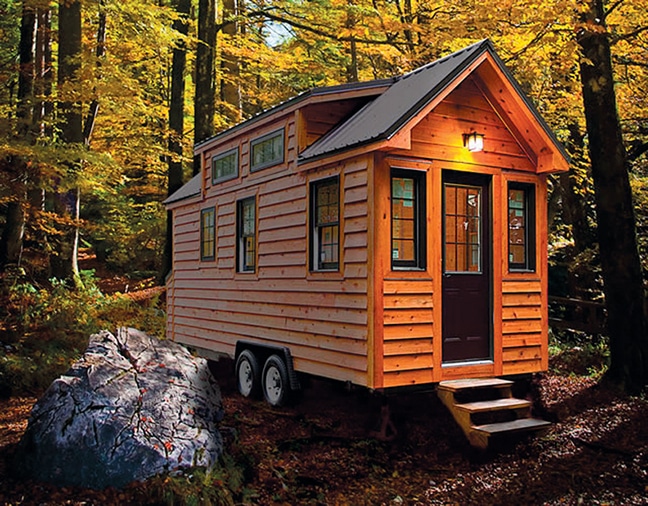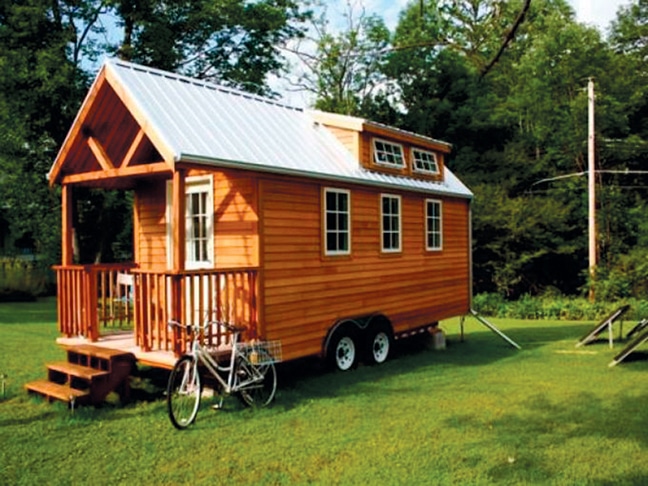Tiny Homes Are Being Seen Nationwide As A Solution To The Homeless Problem. A Local Group Wants To Make It Work In SWLA
By Karla Wall
The notion of living small (some call it “rightsizing”) in today’s world of “more is always better” was first introduced by Sarah Susanka in her book titled The Not So Big House (1997). The financial crisis of 2007-08, and a growing concern for the impact of humans on the environment, made the lifestyle more popular, so much so that in 2012, Jay Shafer founded Tumbleweed Tiny House Company and Four Lights Tiny House Company, both of which manufacture tiny homes on wheels.

Now they’re being seen as a way to provide housing, and a foundation for a better life, for the nation’s growing homeless population. Cities across the nation – Olympia, Wash., which developed Quixote Village for the homeless; Eugene, Ore.; Newfield, N.Y., where you’ll find Second Wind Cottages; Madison, Wisc., which has OM (Occupy Madison) Village; and Austin, Texas, with its Community First! Village — are utlizing these small shelters to house the homeless. New Orleans has implemented the program for veterans.
And statewide programs have developed, as well. Utah, for example, has cut its chronically homeless population by a staggering 91 percent over the past 10 years. And at a lower cost than providing temporary shelters. Participating in this permanent housing program has saved Utah $2,400 per month, per individual helped.
And a local group, Heartstone Foundation SWLA, wants to add SWLA to that growing list.
A Merging Of Ideas
Greg Breaux, president of Heartstone Foundation SWLA, says he’d been interested in the tiny home movement for a couple of years.
“I was keeping up with a Facebook page documenting the building of a small cabin in the woods, built from scraps,” he says.

From left: Dustin DeWalt (project manager), Kasey Countryman (vice president), Cathie Coleman (director), Paul Hite (director/IT), Greg Breaux: (president), Kellie Stawecki (liaison) and Rusty Haven (director).
Breaux also had a soft spot in his heart for the homeless, probably because he had seen firsthand the then-overwhelming homeless population in San Diego when he was serving in the Navy, and had himself fallen on hard times after he left the service.
“I was never officially ‘homeless,’” he says, “but there were times I slept in my car, and times when I didn’t know where my next meal was coming from.”
Back in Lake Charles, he became involved in volunteering for the homeless, and even drove homeless persons to his church for services.
Breaux says the idea for a tiny home village for the homeless here in SWLA came to him during a New Year’s Eve sermon.
“Our pastor spoke about selfless, as opposed to selfish, resolutions,” he says. “He spoke about making a difference; doing something for the greater good, whether it’s for one person or on a bigger scale, instead of resolving to do something for yourself, such as losing weight.”
Driving home, he says, something “clicked,” and the idea of tiny houses and the homeless merged for him.
“I started liking every tiny house page I could find on Facebook,” he says. “And I saw it was a national movement; that many other cities had built tiny home villages for the homeless. And it’s gotten amazing results throughout the country. The idea is simply an application of the tiny home movement.”
Breaux started his own Facebook page based on the idea of a tiny home village for the homeless, and about a month ago, it was brought to the attention of Kasey Countryman, who had moved to the Lake Area from Oklahoma in February of this year. Countryman, too, had a soft spot for the homeless.
“I’d volunteered in Oklahoma, cutting hair once a week at a local homeless shelter,” she says.
Countryman had joined a Facebook page for mothers in the Lake Area, and one of the other members of the group, upon finding out that Countryman had volunteered for the homeless, told her to check Breaux’s page out. Countryman is now vice president of Heartstone Foundation SWLA.
A Growing Group
The group’s Facebook page, in operation for only about three weeks at press time, has over 620 “likes,” and there are about 720 members in the original group Breaux started after the idea for the village hit him.
The group has a 10-member board, and is looking for an 11th board member to provide a tie-breaking vote. There are about 60-75 active members of the group.
“It’s kind of humbling how many people want to be involved,” Breaux says.
Permanent Housing, Rehabilitation, And A Sense Of Community
Breaux and Countryman say that the plan the group has in mind is to create a village, and eventually as many as needed, for the area’s homeless population, which Breaux says is much larger than anyone realizes. Most homeless persons in this area, because of the mild climate, live in non-urban areas — forested areas, fields. So they’re not seen often, so the problem isn’t recognized.
Breaux and Countryman want to set aside four to five acres per village for those homeless persons and families, and provide them the funds and resources to build their own tiny home. Countryman says that 30-40 homes could be placed on an acre of land.

The whole idea of tiny home villages, says Breaux, is permanent housing and rehabilitation, or reintroduction into society, vs. temporary housing that provides shelter but nothing else.
“It will be a permanent house, to provide not only shelter, but a sense of ownership and pride,” says Breaux. “The problem is homelessness. We will provide them a house. Problem solved. Then, they can deal with the rest (of the process of re-entering society). The home would be a stepping stone for those who want more. Without a permanent home, you can’t get food stamps or other government assistance, a driver’s license or a disability check. Residents of these villages would have that home.”
The villages would also provide a sense of community and camaraderie, says Breaux. Not simply a collection of homes, the village would include a community garden, which would supply an on-grounds market; a community kitchen where tenants could prepare meals, and where meals would be prepared for them at least once per week; and a community center.
The villages would also take in food from local resources. “We’re looking at setting up a collection route with places that have excess food to share with the village,” Breaux says.
Residents would be required to work in the community, helping build homes for new members, working in the garden or in the market. Heartstone also wants to work on providing jobs throughout the community working through local workforce rehabilitation programs.
“But that won’t be a condition of moving into the village,” Breaux says. “The idea is housing first.”
Awareness Campaign
But those houses are still a few years off. Breaux and Countryman say the group is probably about two or three years from breaking ground on its first village.
“We’re in the awareness campaign stage right now,” says Countryman.
Heartstone is currently applying for its 501 (c) 3 status, and is busy raising awareness of the group and its goals.
They’re also working to familiarize themselves with local resources for the homeless, hoping to work with them to change the homeless picture in the area. The idea, says Breaux, is not to “step on the toes” of these organizations, but to work with them.
Breaux and Countryman say the group is not currently in negotiations for property; and they realize that they face a rather large hurdle in getting public approval for such villages, not just from local government (the group has sat in on meetings of the Calcasieu Parish Police Jury, and will begin meeting with them and other government agencies to work on zoning and other matters), but from the general population. As one might assume from the recent “discussions” on worker villages, setting aside a four- to five-acre tract to provide housing for chronically homeless persons won’t go over big.
“Everyone loves the idea,” says Breaux, “but no one really wants to look at it.”
How You Can Help
Want to get involved? Simply visit heartstoneswla.org, email info@heartstoneswla.org, or check out the group’s Facebook page at The Heartstone Foundation SWLA.
There’s a signup sheet on the Facebook page, and Breaux says everyone’s help is needed.
“It doesn’t matter what your area of experience is,” he says, “anyone who feels they have something to contribute is welcome.”
And you can join Heartstone for a fundraiser/block party on Aug. 15, 10 am-5 pm, at Water’s Edge Gathering, located at 2760 Power Centre Pkwy. It’ll be a family-fun-filled day of games and activities, including horseshoes, water balloons, bounce houses and bungee jumps. Sample the chili and gumbo prepared by local cooks for the chili and gumbo cook-off contests. There’ll also be a battle of the bands, a raffle and a silent auction. Bowls of gumbo and chili will be sold, with the excess being donated to the homeless. Admission is $15, which includes a bowl of gumbo or chili, and a ballot to vote for your favorite chef. All proceeds will benefit the Heartstone Foundation SWLA.

















Comments are closed.